AI for Construction Drawings: Streamlining Preconstruction
Written by Bridget Cooper

For decades, construction has stuck to its old-school methods – think clipboards, piles of paperwork, and endless Excel spreadsheets.
But times are changing.
The industry, once hesitant to break free from its familiar routines, is finally opening its doors to Artificial Intelligence. In fact, studies predict that the construction industry will have invested a whopping four billion dollars in AI by 2026.
Why the sudden shift?
AI is revolutionizing how construction projects are designed, carried out, and managed – basically every aspect of the building process.
Even though it isn’t hammering nails or assembling apartments just yet, it's tackling the biggest headaches in construction like controlling costs, improving safety, and avoiding project overruns.
In this guide, we'll focus on AI for construction drawings and show you how it is changing this crucial part of preconstruction. We'll also introduce you to a powerful tool that uses AI to make the preconstruction process smoother and less stressful.
Note: If you want to leverage AI to identify bid packages in drawings and create custom subcontractor invite lists, try Downtobid. Our software allows you to turn plans into bid invites in minutes. Try us out here.
AI's Role in Construction
As we've mentioned, AI is already playing a big role across the entire construction project lifecycle. From the initial brainstorming sessions through design, bidding, financing, and operation, all the way to asset management, AI is making its mark. It helps improve accuracy, speed, and efficiency in an industry that has often faced bloated project timelines and wasteful practices.
But there's a lot more nuance to this, and it can be tempting to get carried away. Despite its potential, AI isn't a silver bullet that can solve all estimating and construction challenges.
It's, therefore, important to temper expectations and understand both its capabilities and shortcomings. AI in construction estimating and project management .
What AI Gets Right
Here's where AI shines in construction:
Handling Grunt Work
AI excels for construction plans and managing repetitive tasks related to identifying required scopes, and extracting specified line items from key notes. Automating mundane administrative duties allows architects and designers to devote their time and expertise to solving more complex problems.
Data Analysis
AI can sort through documents, analyze work orders, and spot important details quickly and accurately. Deep machine learning enables AI to tap into existing datasets and product information, accelerating the construction design process. This means less room for mistakes
Alignment Between GCs & Subs
AI facilitates better alignment on scopes between project stakeholders, general contractors, and subcontractors, fostering real-time collaboration.
Detecting Human Errors
AI can quickly pinpoint discrepancies, allowing construction teams to make informed decisions.
Data Organization
It's effective in turning complex data into something structured. For example, it can pull material schedules, like light fixtures and RTUs, and organize them neatly in an Excel sheet for easier communication with vendors.
Where AI Falls Short
Here are some of AI's limitations:
Non-Standardized Plans
AI thrives in ideal conditions, but the real world of construction plans is far from perfect. Each project has unique details or complexities that AI algorithms may struggle to handle.
When plans deviate from the expected format, AI may encounter difficulties in accurately interpreting the data, leading to errors in estimates or analyses.
Expertise and Intuition
AI cannot replace the expertise and intuition of experienced contractors and estimators. For example, understanding the trade-offs between materials, identifying missing details in plans, and making critical decisions based on years of industry knowledge. Such decisions require human judgment and expertise that AI currently lacks.
Lost Context
Construction plans contain a lot of information, from schedules to specifications. However, AI often lacks the ability to discern context within these plans. It can, for instance, fail to differentiate between boilerplate general notes and crucial specifications. This limitation hampers its ability to provide valuable analyses, and you can generally expect unreliable results as a result.
That said, AI's true potential isn't about replacing construction professionals completely but rather complementing their human expertise. In fact, several AI tools are already making a difference in this regard, allowing architects, engineers, and estimators to direct their attention to higher-leverage activities in the construction process.
AI Construction Tools
Every minute spent on manual tasks is a minute lost to productivity and profit.
Fortunately, a lot of AI construction tools have emerged to address this issue, catering to different stages of the construction lifecycle.
Innovative software like mbue, Kreo Software, Togal, and Civils are doing a great job helping quantity surveyors, estimators, contractors, architects, and others save time on accurate takeoffs, construction bidding, project management, and quality control.
Not to blow our own trumpet here, though, but when it comes to AI-powered platforms, few can match the effectiveness of Downtobid. And in just a moment, we'll show you why.
What is DowntoBid?
Downtobid is an AI-powered construction bid management platform that helps GCs automatically identify scopes of work, find qualified local subcontractors, and send personalized bid invites.
Here are a few reasons why Downtobid is the best AI bid invitation software for construction professionals.
Detecting Bid Packages Accurately
Take a set of plans and upload it to our system. Downtobid swiftly extracts basic project information and provides a quick summary.
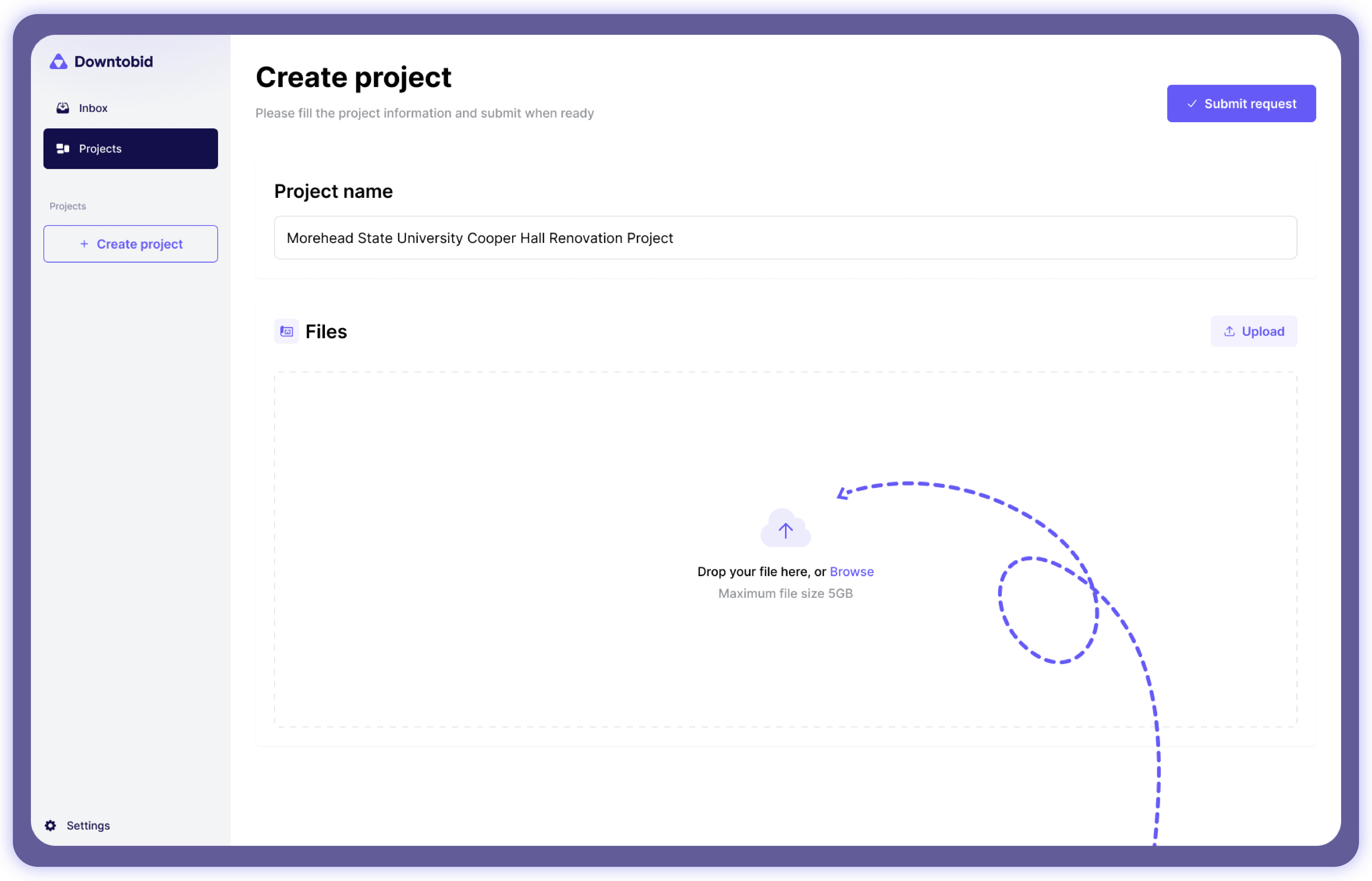
Our AI dives deeper, identifying all the necessary bid packages on the plans.
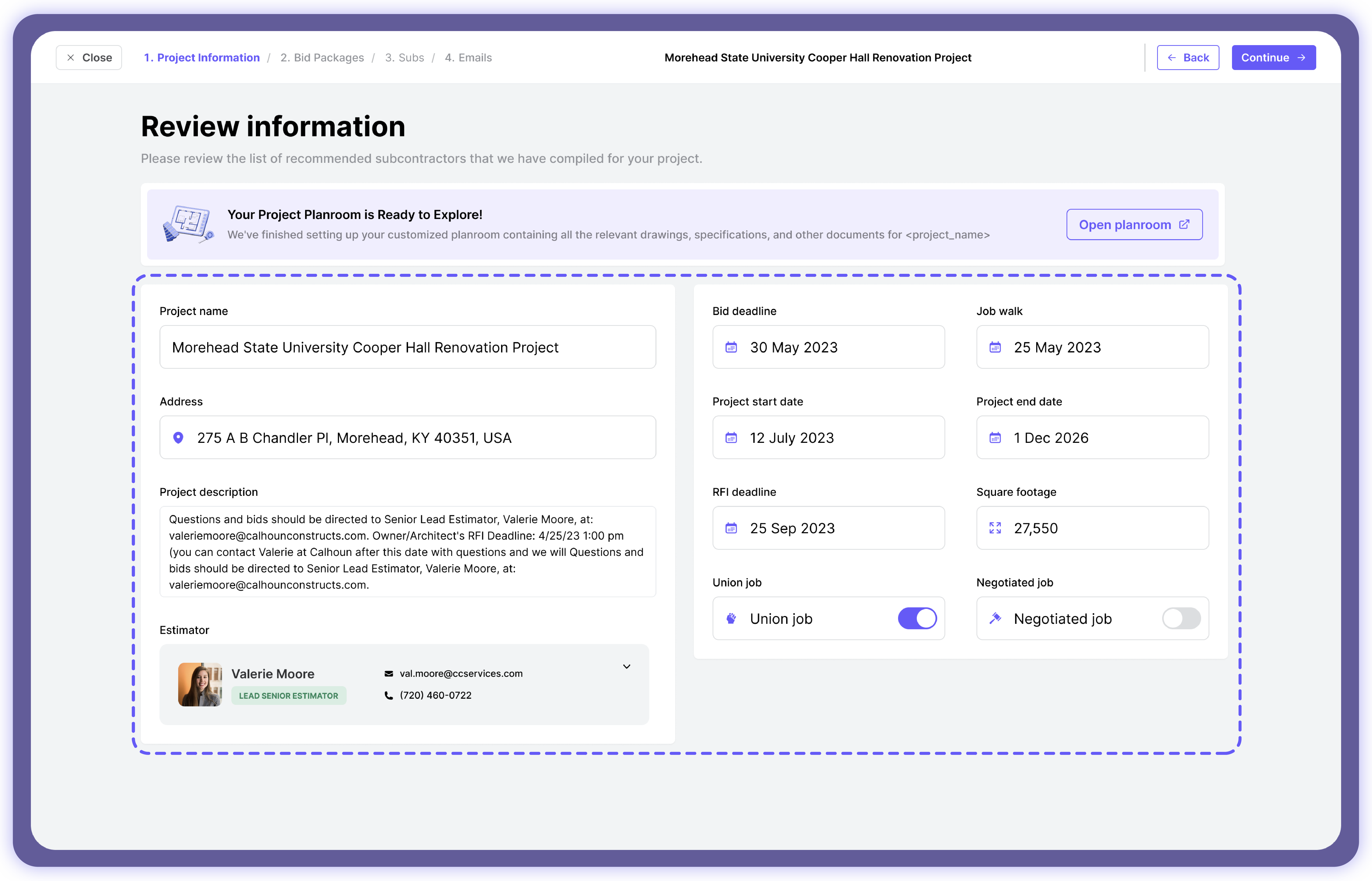
It analyzes the set of plans, pinpointing each bid package, providing a brief explanation of why it's identified as such, and offering reference pages for scope verification.
Our recently launched AI-assisted page turn feature enhances the user experience by overlaying the set of plans with the detected bid packages. Users can visually see where the AI found evidence for each package – also complete with reference pages for further review.
By listing out every piece of evidence, our platform allows you to navigate the project plans with precision. It highlights crucial details that require careful consideration, ensuring nothing slips through the cracks.
Depending on project complexity, Downtobid's bid package detection process typically takes between 10 to 30 minutes. Once complete, users receive email notifications, and bid packages are ready for review.
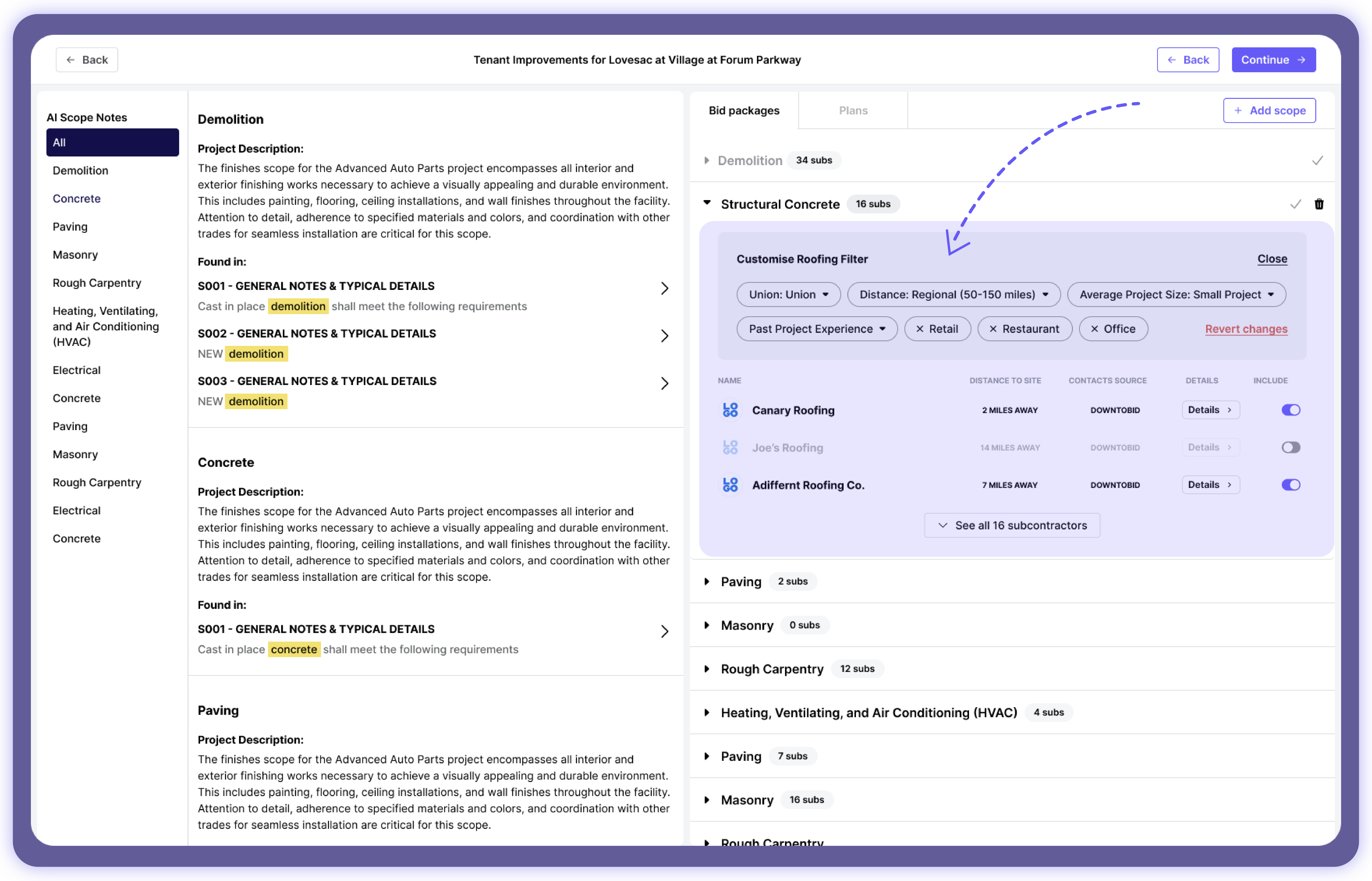
A More Powerful Ctrl-F
When poring over extensive drawing plans — and deadlines are looming — it can be easy to miss important details that could impact your construction project.
Our platform goes beyond the capabilities of a simple ctrl-F; think of it as a turbocharged version of the familiar search function. It not only highlights keynotes, schedules, and phrases but also organizes them cohesively for easy reference.
While GCs might use ctrl-F to look for keywords like "doors" or "hardware," our AI-powered ctrl-F takes it several steps further. Instead of merely scanning for surface-level keywords, it delves deep into the plans to uncover all relevant concepts related to a particular trade.
For example, rather than merely highlighting instances where the word "door" appears, it identifies door schedules, plan locations, specification details, warranties, manufacturers, door types, and even substitution policies.
It compiles all this trade-specific information into a comprehensive "cheat sheet," making sure that no crucial detail escapes your attention.
Gain Access to the Right Subs
After receiving bid packages and logging in, our platform doesn't just leave you on your own. We also provide you with a curated list of recommended local subs — a list that's tailored to your project's trade and location.
You can either invite your preferred subs or explore our extensive subcontractor network for additional options.
To find the right sub for the job, you can use criteria like:
- Trades performed
- Area of work
- MWBE status
- Union/non-union status
- Average project size
- Past projects
- Estimating decision makers (emails & phone numbers)
To top it off, our AI can also suggest an optimal bidding schedule to forward your ITBs, ensuring you're not just reaching out blindly but strategically. The result? Higher response rates.
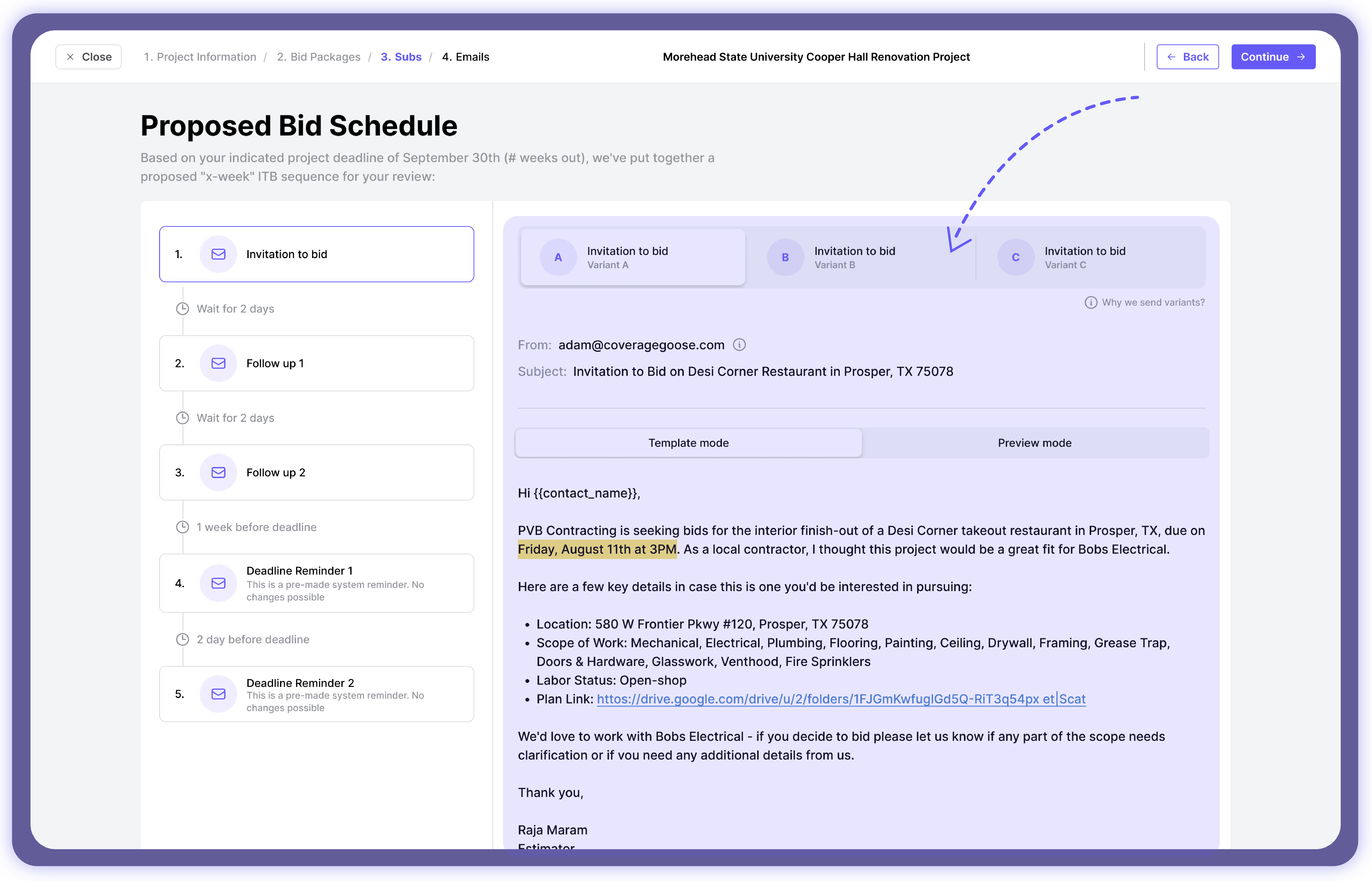
Better Readability and Summarization
Specs can be a pain to read, especially with lengthy text. Nobody wants to sift through a 500-page set of architectural plans when time could be better spent elsewhere.
Our platform offers a solution by condensing specs into manageable summaries. For each bid package, it highlights scope details and the exact location of the scope on the plans. This way, subs can understand their responsibilities and the scope without an exhaustive page-turn.
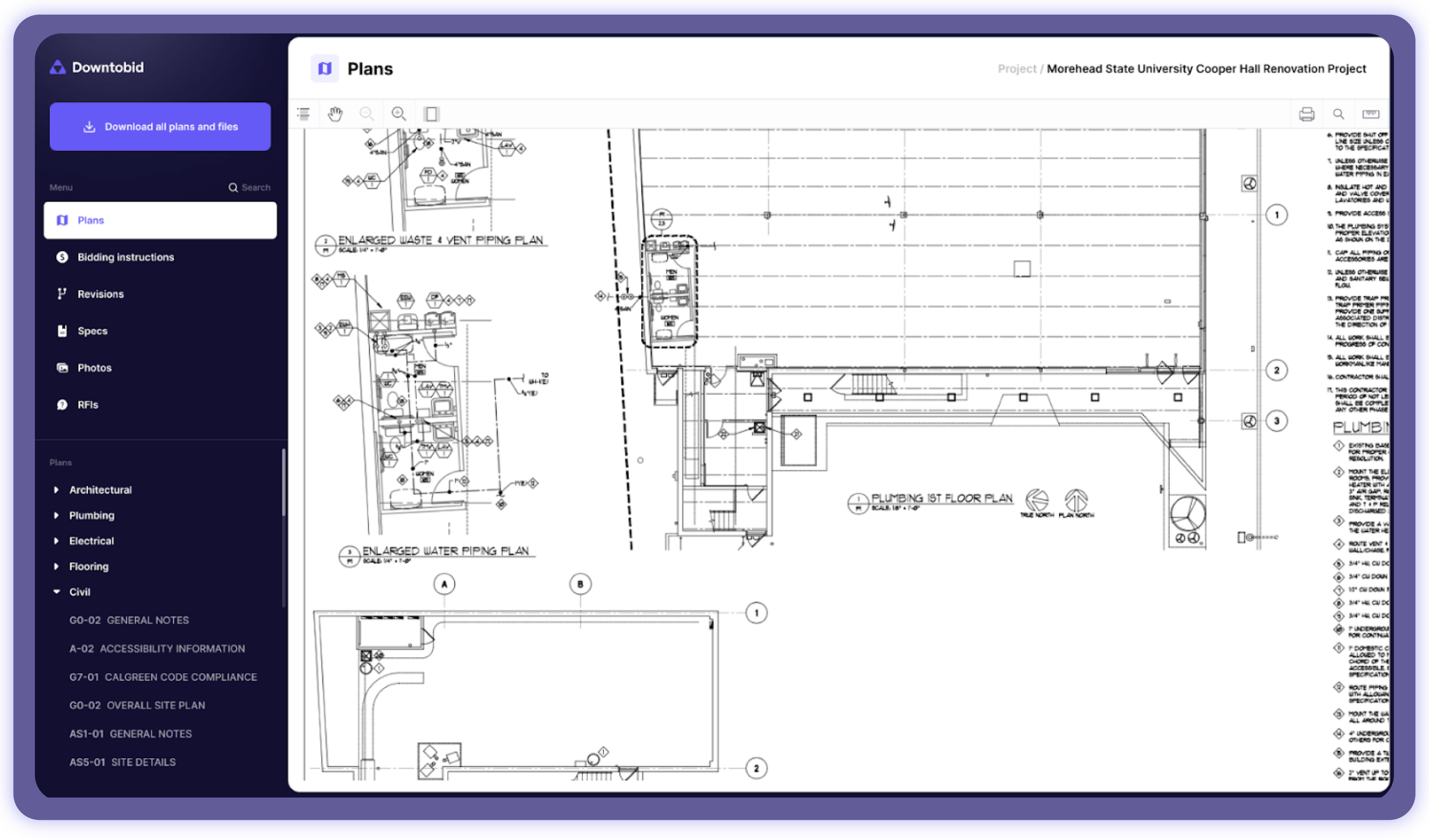
Personalized Invitations to Bid
Even in an industry as technical as construction, building authentic relationships is still important. However, existing platforms often limit you to sending generic, impersonal bid invitations that lack a human touch.
But we don't settle for one-size-fits-all. Our platform generates tailored bid invitations that address subs by name, reference their project history, and acknowledge their trade expertise right from the outset. They also include clear scope summaries that enable subs to quickly assess their fit for the project without diving into the entire plan.
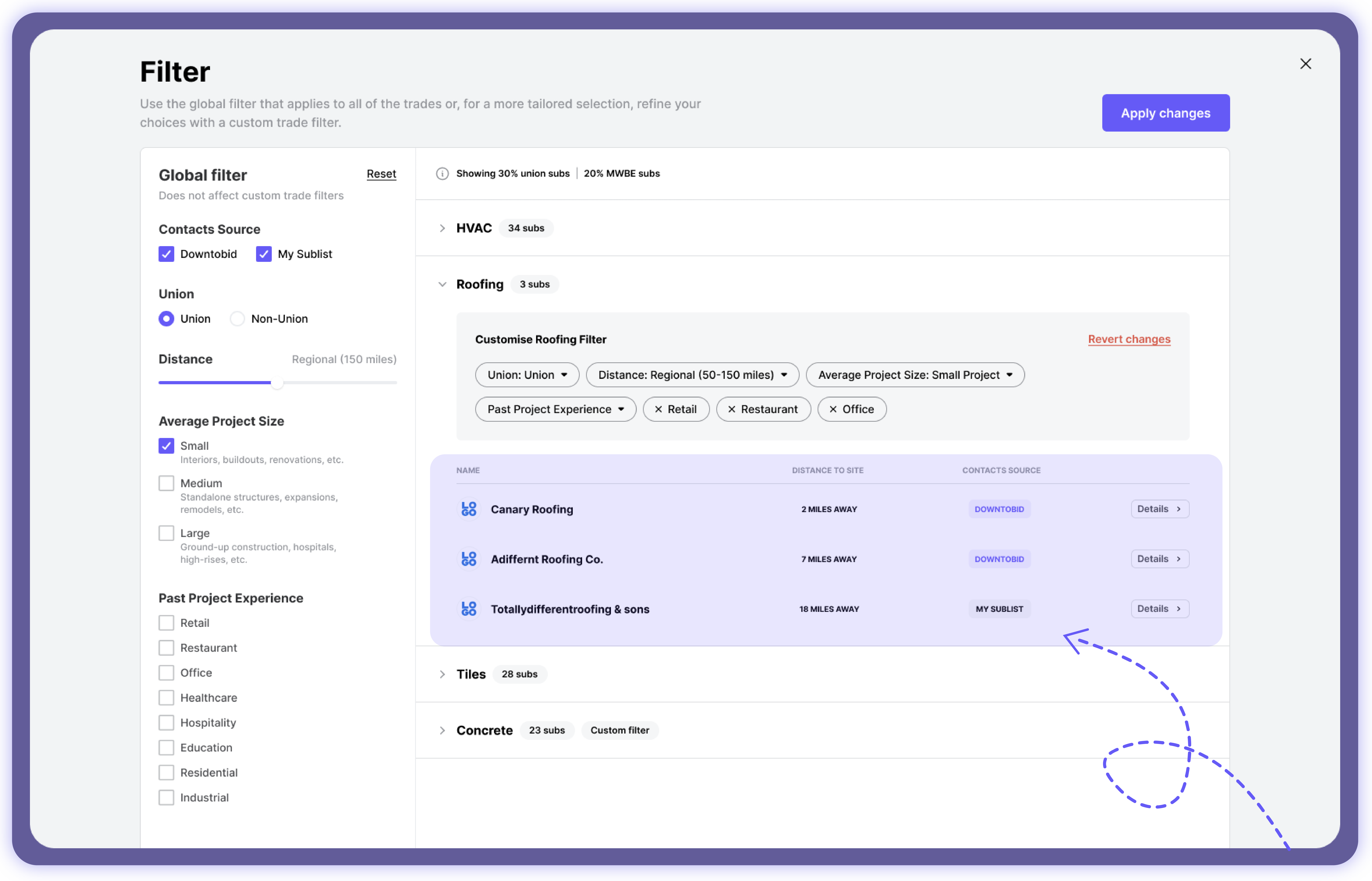
It's a win-win for both you and potential subs.
Subs receive ITBs that align with their experience, eliminating wasted time on proposals for projects beyond their capabilities. You save time that you'd otherwise spend clarifying project details with back-and-forth emails.
Try Downtobid For Free
Getting started with our platform won't cost you a dime. Our free plan provides unlimited access for your whole team, and currently, you can start working on two active projects at once.
Sign up today to accelerate the bidding process, save time analyzing construction plans, and improve subcontractor engagement.
In fact, users report a 30% increase in response rates using our platform. Try us out for free here.